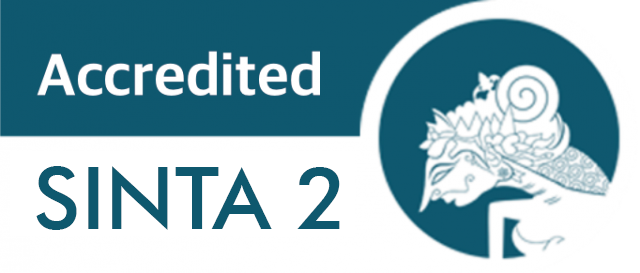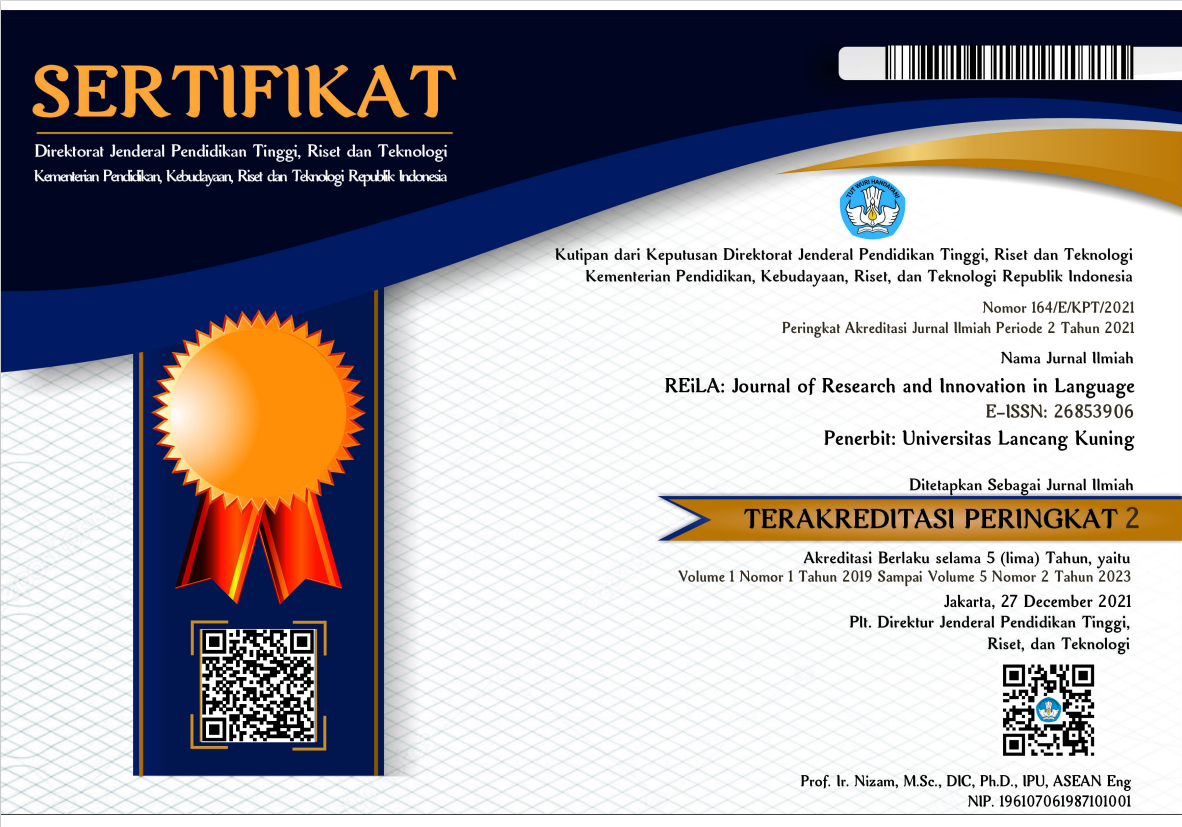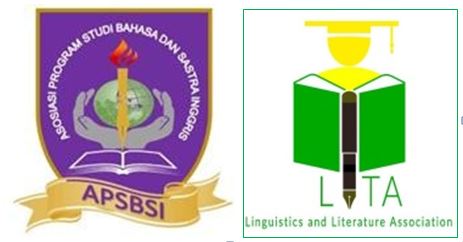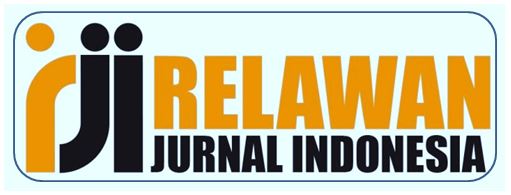Bridging the Gaps between Knowledge and Needs: Sociolinguistics Materials Based on Project-Based Learning
Abstract
Sociolinguistics can help people better understand the use of English in specific social environments. Still, there have been limited studies on the crucial aspects of teaching and learning Sociolinguistics to gain optimum learning outcomes. This present research aims to analyse models of EFL Sociolinguistics materials based on project-based learning required by students and lecturers. A quantitative method was applied in this study, employing a questionnaire and structured interview to collect data from 57 students and three instructors of the English Education Program, Faculty of Teacher Training and Education, Universitas Muhammadiyah Mataram. The results revealed that students and lectures required teaching materials with clear objectives embodied in 11 topics, from Language Variations to Language and Ideology completed with evaluations after each topic, exercises for individuals or groups, and project-based learning, which can be employed in teaching EFL Sociolinguistics. Therefore, designing a model of teaching materials for EFL Sociolinguistics based on Project-based learning is necessary to load these findings. The findings of this study are useful for educators and stakeholders who want to design EFL Sociolinguistics teaching materials. This study has the potential to bridge the gap by providing knowledge about the needs of students and educators as well as recommendations for follow-up in designing EFL Sociolinguistics teaching materials.
Downloads
References
Agustine, S., Asi, N., & Luardini, M. A. (2021). Language use in EFL classroom interaction: A Sociolinguistic study. International Journal of Language Education, 5(4), 372–381. https://doi.org/10.26858/ijole.v5i4.23598
Al-Ahdal, A. A. M. H. (2020). Code mixing in Arabic conversations of college students: A Sociolinguistic study of attitudes to switching to English. Asian ESP Journal, 16(11), 6–19.
Al-busaidi, S., & Al-seyabi, F. (2021). Project-based learning as a tool for student-teachers' professional development: A study in an Omani EFL teacher education program. 20(4), 116–136.
Alan, B., & Stoller, F. L. (2005). Maximising the benefits of project work in foreign language classrooms. English Teaching Forum, 43(4), 10-21.
Albirini, A., & Chakrani, B. (2017). Switching codes and registers: An analysis of heritage Arabic speakers’ Sociolinguistics competence. International Journal of Bilingualism, 21(3), 317–339. https://doi.org/10.1177/1367006915626587
Alderton, R. (2022). T-tapping in standard Southern British English: An ‘elite’ Sociolinguistics variant? Journal of Sociolinguistics, 26(2), 287–298. https://doi.org/10.1111/josl.12541
Alhamami, M. (2020). Switching of language varieties in Saudi multilingual hospitals: insiders’ experiences. Journal of Multilingual and Multicultural Development, 41(2), 175–189. https://doi.org/10.1080/01434632.2019.1606227
Alomoush, O. I. S., & Al-Naimat, G. K. (2020). English in the linguistic landscape of Jordanian shopping malls: Sociolinguistic variation and translanguaging. Asian Journal of Applied Linguistics, 7(1), 101–115.
Austin, J. L. (1962). How to do things with words. Oxford University Press.
Bayyurt, Y. (2013). Current perspectives on sociolinguistics and English language education. The Journal of Language Learning and Teaching, 3(1), 69-78.
Brown, J. D. (1995). The element of language curriculum: A systematic approach to program development. Heinle and Heinle.
Bruyèl-Olmedo, A., & Juan-Garau, M. (2020). Coexisting varieties of English in the linguistic landscape of tourism: the Bay of Palma. Journal of Multilingual and Multicultural Development, 41(2), 157–174. https://doi.org/10.1080/01434632.2019.1606226
Butcher, C., Davies, C., dan Highton, M. (2006). From module outline to effective teaching. Rutledge.
Calude, A. S. (2017). Sociolinguistic variation at the grammatical/discourse level. International Journal of Corpus Linguistics, 22(3), 429–455. https://doi.org/10.1075/ijcl.22.3.06cal
Clements, J. C. (2018). Speech communities, language varieties, and typology. Journal of Pidgin and Creole Languages, 33(1), 174–191. https://doi.org/https://doi.org/10.1075/jpcl.00005.cle
Cunningsworth, A. (1995). Choosing your coursebook. Macmillan Heinemann.
Delisle, R. (1997). How to use problem-based learning in the classroom. USA: Association for Supervision and Curriculum Development.
Dick, W., Carey, L., dan Carey, O. J. (2009). The systematic design of instructional (7th ed.). New Person Education.
Duchêne, A. (2020). Multilingualism: An insufficient answer to Sociolinguistics inequalities. International Journal of the Sociology of Language, 2020(263), 91–97. https://doi.org/10.1515/ijsl-2020-2087
Duke, N. K., Strachan, S. L., & Kim, J. (2020). Putting PjBL to the test : The impact of project-based learning on second graders’ social studies and literacy learning and motivation in low-SES school settings. American Educational Research Journal, 58(1), 160-200. https://doi.org/10.3102/0002831220929638
Ellison, T. M., & Si, A. (2021). A quantitative analysis of age-related differences in Hindi–English code-switching. International Journal of Bilingualism, 25(6), 1510–1528. https://doi.org/10.1177/13670069211028311
Faizin, A. (2015). Sociolinguistics in Language Teaching, MABASAN, 9(2), 66-77
Flesch, M. (2018). "That spelling tho": A Sociolinguistic study of the non-standard form of though in a corpus of Reddit comments. In Proceedings of the 6th Conference on Computer-Mediated Communication (CMC) and Social Media Corpora (CMC-corpora 2018), p. 17-18 September 2018, University of Antwerp (Issue September). https://www.uantwerpen.be/en/conferences/cmc-social-media-2018/proceedings/
Frank, M., Lavy, I., & Elata, D. (2003). Implementing the project-based learning approach in an academic engineering course. International Journal of Technology and Design Education, 13(3), 273–288. https://doi.org/10.1023/A:1026192113732
Fried-Booth, D., L. (2002). Project work (2nd ed.). Oxford University Press.
Gass, J. (2012). Needs analysis and situational analysis: Designing an ESP curriculum for Thai nurses Josiane Gass Payap University. English for Specific Purposes World, 12(36). 1-21
Gelek, K. (2017). Variation, contact, and change in language varieties in Yul shul (Northern Khams). International Journal of the Sociology of Language, 2017(245), 91–111. https://doi.org/10.1515/ijsl-2017-0004
George Yule. (2006). The Study of Language. Cambridge University Press.
Tamargo, R. E., Loureiro-Rodríguez, V., Acar, E. F., & Vélez Avilés, J. (2019). Attitudes in progress: Puerto Rican youth’s opinions on monolingual and code-switched language varieties. Journal of Multilingual and Multicultural Development, 40(4), 304–321. https://doi.org/10.1080/01434632.2018.1515951
Harwood, N. (2010). Issues in materials development and design, in English language teaching material: Theory and practice, Cambridge Language Education.
Heller, B., Szmrecsanyi, B., & Grafmiller, J. (2017). Stability and fluidity in syntactic variation world-wide: The genitive alternation across varieties of English. Journal of English Linguistics, 45(1), 3–27. https://doi.org/10.1177/0075424216685405
Hornberger, N. H., & McKay, S. L. (2010). Sociolinguistics and Language Education. Short Run Press Ltd.
Hussein, H. T., & Kadhim, H. M. (2021). The effect of gender on language use in British novels: A Sociolinguistics study. Journal of Language and Linguistic Studies, 17(4), 2096–2110. https://doi.org/10.52462/jlls.151
Hutchinson, T., & Waters, A. (1987). English for Specific Purposes: A learning-centred Approach. Cambridge University Press.
İlhan, I. (2014). A study on the efficacy of project-based learning approach on social studies education: Conceptual achievement and academic motivation. Educational Research and Reviews, 9(15), 487–497. https://doi.org/10.5897/err2014.1777
Ismail, H., Aceng, R., & Emzir. (2021). Bahan ajar Pemahaman bacaan bahasa Inggris berbasis e-learning moodle. Arden Jaya.
Jolly, D. dan Bolitho, R. (2011). A framework for material writing in material development in language teaching. Cambridge University Press.
Kamp, A. (2012). the Trail of Six Design Projects in the. Proceedings of the 8th International CDIO Conference, pp. 1–22.
Kettanun, C. (2015). Project-based learning and its validity in a Thai EFL classroom. Procedia - Social and Behavioral Sciences, pp. 192, 567–573. https://doi.org/10.1016/j.sbspro.2015.06.094
Khanina, O., & Meyerhoff, M. (2018). A case study in historical Sociolinguistics beyond Europe: Reconstructing patterns of multilingualism in a linguistic community in Siberia. Journal of Historical Sociolinguistics, 4(2), 221–251. https://doi.org/10.1515/jhsl-2017-0016
Khizhnyak, S. P., & Annenkova, V. G. (2021). The variety of language signs in legal terminology: Linguistic and extra-linguistic background. International Journal for the Semiotics of Law, 0123456789. https://doi.org/10.1007/s11196-021-09828-8
Krajcik, J., Czerniak, C., & Berger, C. (1999). Teaching science: A project-based approach. McGraw-Hill College
Lee, H. (2022). A Study on the Change in the Native English-Speaking Teacher Program in Korea: From the Historical Institutionalist Approach. Journal of Asia TEFL, 19(1), 163–179. https://doi.org/10.18823/asiatefl.2022.19.1.10.163
Litlejohn, A. (2011). The analysis of language teaching material: inside the Trojan Horse, Brian Tomlinson, editor, Material Development in Language Teaching. Cambridge University Press.
Liu, H. (2021). Individual variation in attitudes towards Chinese-English code-switching. International Journal of the Sociology of Language, 270, 127–151. https://doi.org/10.1515/ijsl-2020-2118
Long, M. H. (2005). Methodological issues in learner need analysis." In second language needs analysis. Cambridge University Press.
Mairi, S. (2017). Multimedia-based teaching materials for Sociolinguistics course : A research and development project (First stage). Fifth International Seminar on English Language and Teaching (ISELT 2017), 110(Iselt), pp. 126–130.
Meyerhoff, M. (2019). Unnatural bedfellows? The Sociolinguistics analysis of variation and language documentation. Journal of the Royal Society of New Zealand, 49(2), 229–241. https://doi.org/10.1080/03036758.2019.1619599
Mostafizar Rahman, A. R. M., & Mahbuber Rahman, A. R. M. (2021). Linguistic hybridisation in a television talk show: A Sociolinguistics analysis. Journal of Language and Linguistic Studies, 17(2), 767–782. https://doi.org/10.52462/jlls.54
Moylan, W. A. (2008). Learning by project: developing essential 21st century skills using student team projects. International Journal of Learning, 15(9), 287–292. http://ijb.cgpublisher.com/product/pub.30/prod.1895
Mujiono, & Herawati, S. (2021). The effectiveness of e-learning-based Sociolinguistics instruction on EFL university students' Sociolinguistics competence. International Journal of Instruction, 14(4), 627–642. https://doi.org/10.29333/iji.2021.14436a
Muthusamy, P., Muniandy, R., Kandasamy, S. S., Hussin, O. H., Subramaniam, M., & Farashaiyan, A. (2020). Factors of code-switching among bilingual international students in Malaysia. International Journal of Higher Education, 9(4), 332–338. https://doi.org/10.5430/ijhe.v9n4p332
Murchadha, N., & Flynn, C. J. (2018). Educators’ Target language varieties for language learners: Orientation toward ‘native’ and ‘nonnative’ norms in a minority language context. Modern Language Journal, 102(4), 797–813. https://doi.org/10.1111/modl.12514
Orevi, N., & Dannon, R. (1999). Learning Ecology with educational technologies. International Workshop on Science Teachers Education Toward the New Millennium, Haifa, Israel.
Ozyumenko, V. (2020). Addressing a judge in national varieties of English. Russian Journal of Linguistics, 24(1), 137–157. https://doi.org/10.22363/2687-0088-2020-24-1-137-157
Thuan, P. D. (2018). Project-based learning: From theory to EFL classroom practice. In Proceedings of the 6th International OpenTESOL Conference (Vol. 327).
Pourmousavi, Z., & Mohamadi Zenouzagh, Z. (2020). A comparative study of the effect of teacher’s group and individual feedback on Iranian EFL learners’ learning of speech acts in apology letter writing. Asian-Pacific Journal of Second and Foreign Language Education, 5(1). https://doi.org/10.1186/s40862-020-00088-w
Proshina, Z. G., & Nelson, C. L. (2020). Varieties of English and Kachru’s expanding circle. Russian Journal of Linguistics, 24(3), 523–550. https://doi.org/10.22363/2687-0088-2020-24-3-523-550
Ramzan, M., Aziz, A., & Ghaffar, M. (2021). A study of code-mixing and code-switching (Urdu and Punjabi) in children’s early speech. Journal of Language and Linguistic Studies, 17(2), 869–881. https://doi.org/10.52462/jlls.60
Richard, J. C. (2001). Curriculum development in language teaching. Cambridge University Press.
Ritchie, M. (2011). Developing Sociolinguistics competence through intercultural online exchange. Second Language Teaching and Learning with Technology: Views of Emergent Researchers, 2011, 123–141. https://doi.org/10.14705/rpnet.2011.000009
Rodríguez, J., Laverón-Simavilla, A., Del Cura, J. M., Ezquerro, J. M., Lapuerta, V., & Cordero-Gracia, M. (2015). Project Based Learning experiences in the space engineering education at Technical University of Madrid. Advances in Space Research, 56(7), 1319–1330. https://doi.org/10.1016/j.asr.2015.07.003
Saputra, J., Rahmadeny, M., & Jazzawi, I. (2019). The Importance of Sociolinguistics in foreign language education : A review of selected paper. International Journal for Educational and Vocational Studies, 1(4), 299–303.
Shuhailo, Y. V, & Derkach, T. M. (2021). Project-based learning for undergraduate engineering students minoring in textile technology and design project-based learning for undergraduate engineering. Journal of Physics: Conference Series. https://doi.org/10.1088/1742-6596/1840/1/012042
Simatupang, E. C. M., & Amalia, S. (2019). A Sociolinguistics study of code switching among overseas Indonesian students on Facebook comments. International Journal of Innovation, Creativity and Change, 7(9), 232–237.
Simpson, J. (2011). Integrating project-based learning in an English language tourism classroom in a Thai university. [PhD Thesis]. Australian Catholic University.
Subhan, B. (2004). Psycholinguistics, Sociolinguistics, dan Semantics (an Interdisciplinary approach). Yogyakarta: LPPDMF.
Sugiyono. (2009). Motedology penelitian. Campaka mas.
Tankosić, A., & Dovchin, S. (2021). The impact of social media in the Sociolinguistics practices of the peripheral post-socialist contexts. International Journal of Multilingualism, 42(6), 1-25. https://doi.org/10.1080/14790718.2021.1917582
Tarihoran, N., Fachriyah, E., Tressyalina, & Sumirat, I. R. (2022). The impact of social media on the use of code mixing by generation Z. International Journal of Interactive Mobile Technologies, 16(7), 54–69. https://doi.org/10.3991/ijim.v16i07.27659
Thomas, J. W. (2000). A review of research on project based learning. http://www.bie.org/research/study/review_of_project_based_learning_2000
Tomlinson, B. (2013). Development material in language teaching. Continuum International Publishing.
Tramutoli, L. (2021). The code-mixing of the Senegalese migrants in Italy. International Journal of Bilingualism, 25(5), 1235–1262. https://doi.org/10.1177/13670069211008243
Vari, J., & Tamburelli, M. (2020). Standardisation: bolstering positive attitudes towards endangered language varieties? Evidence from implicit attitudes. Journal of Multilingual and Multicultural Development, 41(6), 1–20. https://doi.org/10.1080/01434632.2020.1829632
Wainwright, G. (2006). Speed reading better recalling. Gramedia Pustaka Utama.
Wardhaugh, R., & Fuller, J. M. (2015). An introduction to Sociolinguistics (7th Edition). John Wiley & Sons. Inc.
Witkin, B. R., & Altschuld, J. W. (1995). Planning and conducting need assessments: A practical guide. Thousand Oaks
Yule, G. (1996). Pragmatics. Oxford University Press.
Zibin, A., & Al-Tkhayneh, K. M. (2019). A sociolinguistic analysis of the use of English loanwords inflected with Arabic morphemes as slang in Amman, Jordan. International Journal of the Sociology of Language, 2019(260), 155-175. . https://doi.org/https://doi.org/10.1515/ijsl-2019-2052










